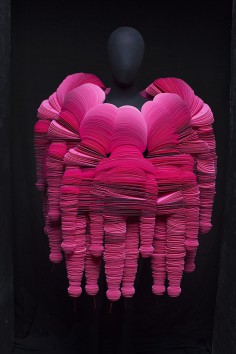Bea Szenfeld
Paper Ensemble

source: vogue
The paper doll–style dresses Jeremy Scott sent down the runway at Moschino in Milan for Spring 2017 were, observed Nicole Phelps, a “critique [of] our social media–mad world,” in which everything is rendered in 2-D. Scott’s conceit was also a reminder that the first life of many a fashion design is as a sketch. This work on paper assumes added dimensions when it is translated into fabric—or other materials.
Never coming up flat is the work of Bea Szenfeld, a Polish-born, Stockholm-based artist whose medium is paper. Szenfeld worked as a ceramicist and sculptor before pursuing a fashion degree at Beckmans College of Design in Stockholm. After graduating, she landed a job in the industry. Quickly realizing that working with commercial clothes was not her thing, she “jumped back to work with clothes in art.”
Inspired by the experimental garments she made at school, Szenfeld chose to work again with paper, a material, she says, that “has its own plan, its own life. I can do whatever I can to make it comfortable and to stay the way it was from the beginning,” she explains, “but still sometimes the paper just does stay. I don’t even know what it’s going to do. I love working with paper; it’s like having a coworker.” Judging by the pieces recently on display at Stockholm’s Dansmuseet, , and which move to Berlin this week, one can imagine this colleague being an opinionated one. Szenfeld’s handcrafted pieces command attention, and space: She was limited to displaying only the garments that could fit through the building’s door.
Each piece is handmade in a process that might be described as analog, and is constructed using materials that can be found in any corner stationary or hardware store: scissors, tape, staples, bone folder, needle and thread, paper, sometimes a glue gun or drill. Some of Szenfeld’s pieces feature origami folds, others are accumulations of thousands of individual pieces, some separated by a small pearl. “I get a lot of help from my assistants, but I always do the last [bit]. I have to. The garments are so heavy that I really don’t know until we are done with all the pieces how I shall put it together.”
How to place Szenfeld’s work on the art-fashion continuum? The artist says she’s not thinking about selling her garments as she makes them. Still, she’s cognizant of the fashion system and she finds alternative (i.e., off the catwalk) ways to present her “collections,” which have been bought by collectors and worn on the red carpet—by Björk, of course!—and in music videos. (Check out Lady Gaga’s “Guy.”) Recent projects include work for the Royal Swedish Ballet, and for the Eurovision Song Contest.
Even when still, Szenfeld’s garments are never static: “Paper changes, I cannot do anything about it,” explains the artist, who is delighted when her garments are worn. At Eurovision, where dancers performed in her designs, there was, she says, there was “everything you needed to make the clothes be alive.” Still, she thinks exhibitions are important, especially in a world where there is so much manipulation of information and images. “It’s important that people can come to an exhibition and look really closely, [and realize] ‘Oh my God, it is done by hand!’ ”

